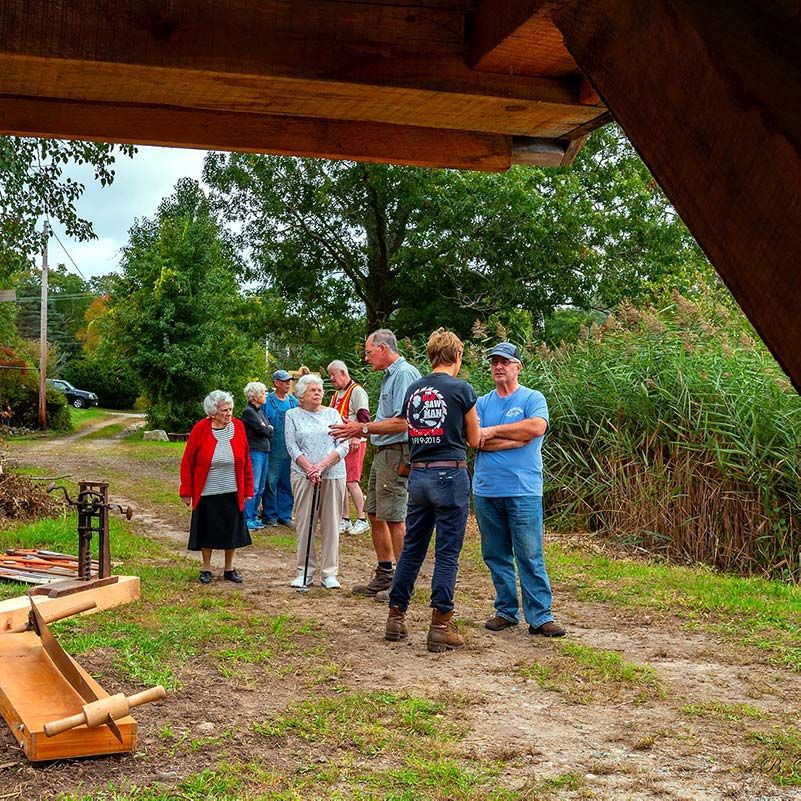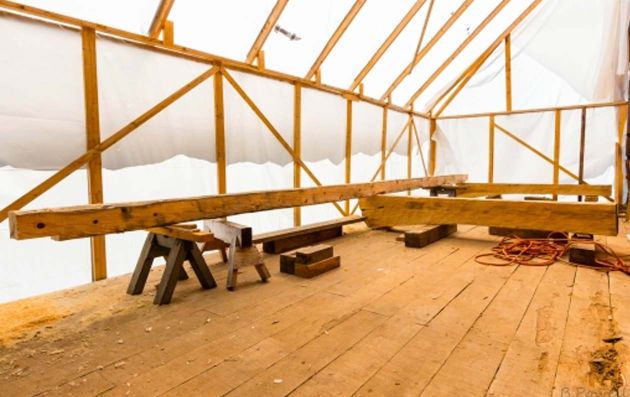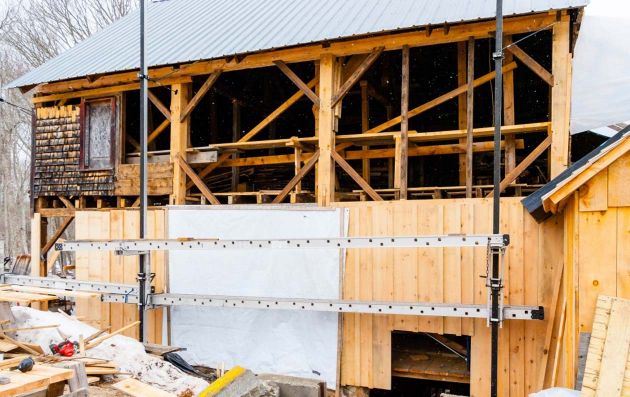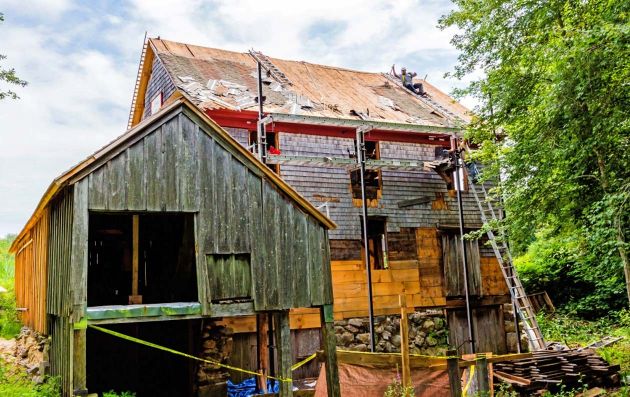Preserving
The Marshfield Historical Society ran fundraising campaigns from 1968 through the 1980’s to “save the Hatch Mill” In those days many contributors had been customers at the mill or recalled its operation. As time went on machinery was removed to make structural repairs. The idea to replicate the original “up and down” saw seems to have originated in these years. There were references that much of the original saw was stored above the box mill but that was either exaggerated or the parts were lost. Major structural damage and near collapse of the building had reached a critical point by the 1990’s.
In 2004 the late Roy Kirby mobilized a group that formed a non-profit entity, The Hatch Mill Restoration and Preservation Group. Marshfield residents Roy Kirby and his partners, Jack and Bob Clancy, bought the property from the Marshfield Historical Society for $1, with the condition that they would take over the $40,000 mortgage, restore the mill and leave the land undeveloped.
The group was later incorporated as the Hatch Mill Group, Inc. which is a 501(c)(3) non-profit. In recent years with generous Town and State support through the Community Preservation Act, many private donors, and the support of neighbors, we have completed the restoration of the building. The restoration work was done by MLB Restorations and students from the North Bennett School beginning in 2013.
Jacob Barton, a local mason, was hired to rebuild the spillway using granite block. A white oak frame and slip in stopboards/planks were incorporated into the spillway to control the pond water level.
The mill and spillway have been restored in a historically sensitive manner to how it appeared when it was expanded in 1859.
With the building’s structure restored there is still much work required to turn this property into a museum with an operating sawmill.
In 2022 the Board began the restoration of the sawmill infrastructure. Upon completion the Hatch Mill will be the only working water-powered sawmill on the South Shore, likely the only working one in Massachusetts, and one of a handful in New England. It is an extremely rare example of a 19th century industrial building that was once commonplace and was extraordinarily important to the development of our nation.
For many years the preservation and reconstruction objective was to recreate the 1812 sash sawmill. However, at present we have only two remaining components of that sawmill - a fender beam (removed due to structural decay, but retained for study and exhibit) and a sash saw blade found in the pond. The rest of the design would be conjectural based on a very small sample of New England sash saws that remain or were documented (none of which are from this region).
In 2020 the Hatch Mill Board of Directors voted to revise the preservation plan to reinstall the 1872 Forsaith Sawmill, which had been kept in off-site storage for the duration of the building restoration. For this mill and the Houston Turbine we have nearly all the parts of and it was these components that were in use until the mill closed in 1965. The Forsaith carriage and setworks design is a rare example of an early circular sawmill.
From a preservation standpoint, it would be inappropriate to create a conjectural mill - the sash mill - when we have the intact mill which was in use for nearly a century. Moreover, the box mill building, added in 1859 is a prominent part of the Hatch Mill. This contains the original box mill infrastructure. If choosing 1812 as the period of interpretation, the 1859 structure would not fit the context.
For the above reasons, the preservation plan is to repair and reinstate the 1872 Sawmill. The turbine may not be in repairable condition. To date, the Board has not decided on an approach for reconstruction. This could entail having molds made and recasting a Houston Turbine, finding a period turbine with similar specifications, or another approach.
1872 Circular Sawmill Restoration
The sawmill was manufactured by the S.C. Forsaith Manufacturing Company of Manchester, New Hampshire. The 1867 patent application and S.C. Forsaith catalogs from that era with renderings of sawmills have been our best reference material.
Restoration of the circular sawmill began in 2022, when we brought the saw carriage and husk back to the mill from off-site storage. Since then we’ve procured and began replicating the log beam with a new timber of reclaimed and resawn longleaf pine. We’ve had the missing log dogs and dog rests replicated by a blacksmith. And, we’ve disassembled the set works and began cleaning.
Next steps include cleaning and repairs to the mill’s other mechanical assemblies including bearings, setworks, and pulleys. We need to repair the tracks the carriage rides on, for which we have reclaimed/resawn longleaf pine timbers. The drive shaft and pulley systems need to be restored and possibly will need to procure additional parts. The saw blades will require restoration and sharpening. We will need to build a log deck outside of the mill to roll the logs into the mill.
1859 Box Sawmill Restoration
Most of the infrastructure for the short log sawmill and crosscut saw remain, but will require significant repair including the lineshaft drive system. We have not determined the original design or manufacturer of this equipment, it may be an example of “yankee ingenuity” using parts from multiple machines.
Belt-driven Woodworking Machinery
The Hatch Mill’s collection contains woodworking machinery acquired from the long gone Randall Organ Factory that was located on Littles Creek in Marshfield. These machines include a joiner, planer, bandsaw, and table saw. All belt driven, these machines date from the same era (1870’s) as the sawmill. This equipment will be installed in the upper level of the box mill which had been used as storage.
To integrate these into the mill’s working collection we will need to design and install the drive system and layout, clean machines, install machines in their final locations, procure missing blades, etc.
Powering the Mills
The Hatch Mill Pond is located on the Two Mile Brook. The brook feeds into the North River. Today the mill pond is silted in and is filled with phragmites, an invasive type of perennial grass. The dam that surrounds the pond has a small leak where the brook exits the pond and a low point that needs infill. In addition to restoring function to the sawmill, restoring the pond will bring back the scenic pond vista.
This final phase of the Hatch Mill restoration will restore water power to the mill building. To do this we need to complete studies of how modern era changes to the upstream and downstream water course (including any effect on flow) will impact powering the turbine. A study of the sluice functionality will also be needed, because at some point after closure of the mill the sluice gate and spillway were rebuilt. There is no known documentation of the design of this, so a study of its functionality to power the turbine is necessary. A head gate will also need to be designed, constructed and installed.
Pending these studies and funding, the engineering (e.g. permitting, surveying, site planning, testing, site prep) can be completed for pond hydro-raking/dredging, dam repair and possibly tail race dredging and the pond restoration can proceed. Once completed the pond will require ongoing maintenance to keep the slit and grasses from once again taking over. For these reasons restoration of the pond will probably be the last task to be completed.
Prior to water power restoration we are planning to bring electric or mechanical power to the mill. A motor will power the mill by transferring power to the historic line shafts, pulley wheels, belts and gears.
The historic turbine that originally powered the mill was extracted from under the mill and sits in the parking area. It likely cannot be restored, but may be able to be used to model casting molds to manufacture a replica. Alternatively we may source another period turbine with similar power specifications. Once completed, we will install the turbine in the building and connect it to drive the mill, but with the ability to switch to the motor as needed.
Additional work to complete the Museum
As restoration progresses there are many tasks required to improve the museum experience. These include signage, manuals for equipment operation and docents, and parking / restroom facilities.
We are also in the process of archiving our collection of historic materials. This information will be used for the restoration process and future programs for schools and other visitors.







